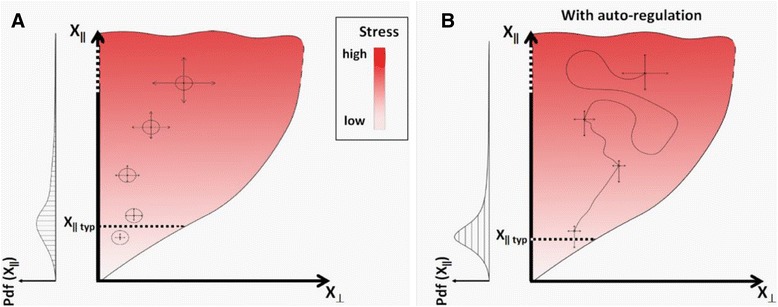Fig. 2.

A visual metaphor illustrating adaptive improvisation by random drive reduction. Improvisation (or exploration) is defined as a change in state (or part of the change) which is not specified by pre-evolved mechanisms. Improvisation which reduces the stress is termed 'adaptive' (or ‘beneficial’). Illustrations with and without re-enforcement are shown in (a) and (b), respectively. a Heuristic depiction of the state space available to the organism (colored area). At any given moment, the state is represented by a high dimensional vector X, which specifies a point in the available state space. The overall amount of stress, S, at a given state, is displayed in red color code (for simplicity of the illustration, we only consider here a single measure of stress at the whole organism level). The available state space is divided into two subspaces, Xǁ and X⊥, defined as follows: Changes in state upward along Xǁ increase the overall stress while changes along X⊥ have no effect on the stress (‘no effect’ means that the change in stress is below a small threshold). Thus, the stress S in this representation, is an increasing function ƒ of the state along Xǁ, i.e. S = ƒ(Xǁ). Additionally, the characteristic magnitude of exploratory changes (|ΔX| char) is assumed to be an increasing function G of the stress, i.e. |ΔX| char = G(S). Consequently, the lower the stress, the smaller the ‘perimeter’ of subsequent exploration, and the state of the organism is more likely to remain (over a specified time interval) within a given neighborhood of the starting state (circle). This biases the outcome towards less stressful states, even without directed movements in the state of possible changes. The tendency toward lower stress is counteracted by having a smaller number of stress-reducing states compared with states associated with increased stress. The balance between the tendencies to decrease and increase the stress depends on the characteristics of G(S) and the relative abundance in the number of stress-reducing versus stress increasing states. We assume that in the regime of very high stress, the over-abundance of stress-increasing states becomes small and the overall balance would favor decrease in stress due to drive reduction. However, in the inverse regime of very low stress, states which increase the stress are much more abundant than stress-reducing states and the exploratory changes will tend to increase the stress. The combined effects of upward and downward tendencies create an intermediate domain, in which the organism is most likely to be found (around Xǁ typ). A qualitative profile of a probability density function (Pdf) for a particular state along Xǁ, is shown to the left. b Amplification and stabilization of beneficial changes by auto-regulatory processes. Random occurrence of beneficial processes that are also capable of re-enforcing themselves (or each other), enhance the process of stress reduction thus increasing the benefit. Since the resources of every system are limited, activation of beneficial auto-regulatory processes tend to repress other processes, thereby stabilizing the beneficial processes. Subsequent changes, in this case, become more likely to decrease stress (indicated by substantially asymmetric arrows), thus expediting the adaptation, stabilizing its outcomes and reducing the probability of more harmful changes
